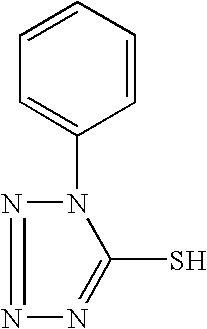Silver halide emulsion and silver halide photographic material
- Summary
- Abstract
- Description
- Claims
- Application Information
AI Technical Summary
Benefits of technology
Problems solved by technology
Method used
Image
Examples
example 1
Preparation of Silver Halide Emulsion
[0329] Silver halide emulsions were prepared in the following manner.
Preparation of Silver Halide Emulsion (B-1)
[0330] To 1 liter of an aqueous 2% solution of deionized ossein gelatin (containing 10 ppm calcium), maintained at 40° C. were solutions (A1) and (B1) for 20 min, while controlling the pAg and pH at 7.3 and 3.0, respectively. Subsequently, solutions (A2) and (B2) were added for 90 min with controlling the pAg and pH at 8.0 and 5.5, respectively. Solution (C1) was added, and then, solutions (A3) and (B3) were added over 15 min. with controlling the pAg and pH at 8.0 and 5.5, respectively. The pAg was controlled in accordance with the method described in JP-A No. 59-45437 and the pH was controlled using aqueous sulfuric acid or sodium hydroxide solution.
Solution (A1)Sodium chloride3.42gPotassium bromide0.03gWater to make200mlSolution (A2)Sodium chloride71.9gK2[IrCl6]3.0 × 10−8mol / mol AgXK2[IrBr6]1.0 × 10−8mol / mol AgXK4[Fe(CN)6]2.0 ×...
example 2
[0388] Using photographic materials prepared in Example 1, 127 mm wide roll form samples were prepared and evaluated with respect to suitability for digital exposure.
[0389] Thus, negative images of processed negative film (Konica Color New CENTURIA 400) were digitized using a film scanner, Q scan 1202JW (available from Konica Corp.) so as to be treatable using computer software, photoshop (Ver. 5.5, available from Adobe Co.). Further to the thus treated images, letters of various sizes and fine lines were added to form image data and operated so as to perform exposure using the following digital scanning exposure apparatus.
[0390] As light sources were used a 473 nm laser which was obtained by subjecting YAG solid laser (oscillation wavelength: 946 nm) using semiconductor laser GaAlAs (oscillation wavelength: 808.5 nm) as an exciting light to wavelength conversion by a SHG crystal of KNbO3; a 532 nm laser which was obtained by subjecting YVO4 solid laser (oscillation wavelength: 10...
example 3
[0417] From negative images of processed negative film (Konica Color New CENTURIA 400), positive images of processed reversal film (Konica Chrome SINBI 1200 High Quality) and photographing image data taken by a digital camera Digital Revio KD-200Z (available from Konica Corp.), print images were obtained in accordance with the following procedure.
[0418] There were prepared roll form samples of 127 mm width, using photographic materials prepared in Example 1. The samples were exposed and processed in Konica digital minilab system QD-21 SUPER (in which print processor QDP-1500 SUPER and processing chemicals ECOJET-HQA-P were employed and processing is conducted in accordance with process CPK-HQA-P). The obtained print samples were evaluated similarly to Example 2. Results thereof are shown in Table 5. Similarly in Example 2, it was proved that samples relating to this invention achieved superior effects. Specifically, when the bromide content and the iodide content of silver halide g...
PUM
 Login to View More
Login to View More Abstract
Description
Claims
Application Information
 Login to View More
Login to View More - R&D
- Intellectual Property
- Life Sciences
- Materials
- Tech Scout
- Unparalleled Data Quality
- Higher Quality Content
- 60% Fewer Hallucinations
Browse by: Latest US Patents, China's latest patents, Technical Efficacy Thesaurus, Application Domain, Technology Topic, Popular Technical Reports.
© 2025 PatSnap. All rights reserved.Legal|Privacy policy|Modern Slavery Act Transparency Statement|Sitemap|About US| Contact US: help@patsnap.com



